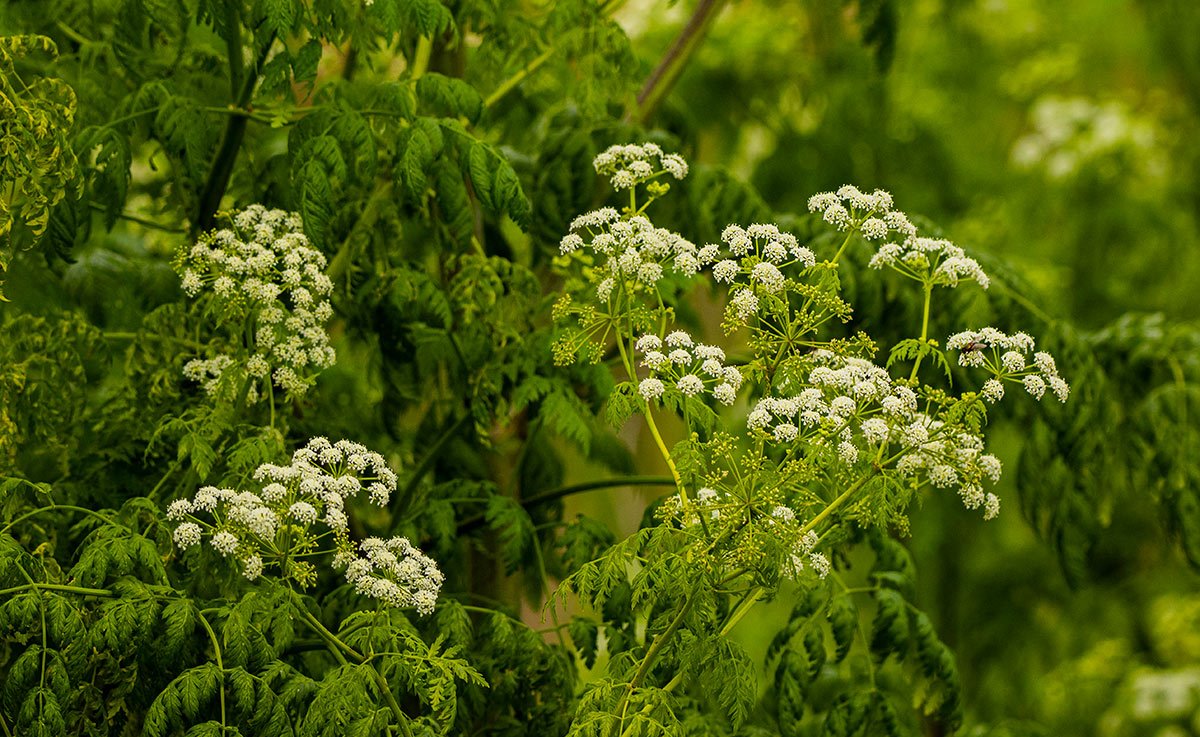Conium maculatum is a very well-known plant because of its strong poison. Most people call it Poison Hemlock, but it is also known by other names like Devil’s Porridge, Spotted Hemlock, Beaver Poison, Poison Parsley, and Musquash Root. It belongs to the Apiaceae family, which is the same family as carrots, parsley, and coriander — but while those are safe to eat, Poison Hemlock is highly poisonous.
This plant is native to Europe and North Africa but is now found in many parts of the world, including India, the United States, and other temperate countries.
Plant Description:
Poison Hemlock is a tall herb that grows very quickly. Let’s understand how it looks:
-
Stem: The stem is green but has noticeable purple or reddish spots. It is hollow inside and can grow as tall as 2 to 3 meters (about 6 to 10 feet).
-
Leaves: The leaves look a lot like parsley or carrot leaves. They are large, finely divided, and bright green.
-
Flowers: In summer, Poison Hemlock produces small white flowers. These flowers grow in umbrella-shaped clusters called umbels. These flowers are quite pretty, but dangerous.
-
Seeds: The plant makes a lot of seeds, which spread easily. This is why the plant can quickly grow and cover large areas, sometimes even taking over farm fields and roadsides.
Chemical Makeup:
The reason Conium maculatum is so dangerous is because of special chemical compounds called piperidine alkaloids. The main poisonous chemicals in the plant are:
-
Coniine
-
Gamma-coniceine
-
N-methylconiine
-
Conhydrine
Out of these, Coniine is the most dangerous one. It affects the nervous system, stopping the messages between the brain and the muscles. This can lead to paralysis (when a person cannot move their muscles) and other serious problems.
The plant makes these chemicals naturally to protect itself from animals that might try to eat it.
Toxic Effects:
Poison Hemlock is one of the most toxic plants in the world. Eating any part of the plant — whether it's the leaves, flowers, seeds, or roots — can be life-threatening.
The symptoms of Poison Hemlock poisoning include:
-
Tingling in the mouth and skin
-
Weakness and shaking
-
Dizziness and confusion
-
Difficulty in speaking
-
Paralysis (unable to move parts of the body)
-
Difficulty breathing
-
And in very bad cases, death from respiratory failure (when the person’s lungs stop working)
Even touching the plant and then rubbing your eyes or mouth can be harmful, so it should be handled with great care.
Famous Incident:
The philosopher Socrates was executed in ancient Greece by being made to drink a cup of hemlock poison. It is said that he slowly lost the ability to move and speak, and finally died when his breathing stopped.
Traditional and Medicinal Uses:
Despite its dangerous nature, Poison Hemlock was used in ancient medicine for its calming and muscle-relaxing effects.
Some of the historical uses include:
-
As a sedative to help people sleep
-
To treat convulsions and spasms
-
In old times, it was also used for:
-
Breast tumors
-
Tuberculosis
-
Syphilis
-
Chronic skin problems
-
Painful urinary diseases
-
As a part of traditional remedies for cancer
-
Doctors like Dr. Mattei used it in medicines for difficult diseases. It was included in mixtures called "Cancerosos" remedies in ancient homeopathy.
Important Note:
Today, doctors no longer use this plant in modern medicine because it is too dangerous and unpredictable.
History and Cultural Importance:
-
In Ancient Greece, Poison Hemlock was used for executions.
-
In Ireland, it was called Devil’s Porridge because of its deadly effects.
-
Some cultures mistakenly thought it had magical powers because of how quickly it could affect the body.
-
Farmers feared it as it could poison livestock like cows, horses, and sheep if they ate it by accident.
Where It Grows:
Poison Hemlock usually grows in:
-
Fields
-
Roadsides
-
Riverbanks
-
Empty land or abandoned areas
It loves moist, rich soils and spreads very quickly once it flowers and produces seeds.
Speech Disorder
A speech disorder, also known as a speech impairment...
ADHD
Attention-deficit / hyperactivity disorder (ADHD) is a...
Cerebral Palsy(CP)
Cerebral palsy (CP) is a group of neurological disorders...
Cancer
Cancer is a broad term for diseases where cells...




